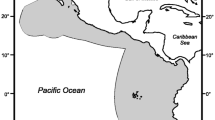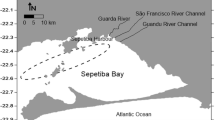Abstract
Shellfish harvesting in intertidal areas is a widespread and economically important activity in many countries across West Africa. However, in some areas, there is virtually no information concerning the levels of contaminants (and other elements related to nutritional aspects) in the harvested species. We collected sediments and several individuals of the West African bloody cockle Senilia senilis and of the razor clam Tagelus adansoni during the dry season of 2015 nearby three islands in the Bijagós archipelago, Guinea-Bissau. Aluminium, Ca, Fe, Mg, As, Cd, Co, Cr, Cu, Mn, Ni, Pb and Zn were determined in sediments and whole soft tissues of the two bivalves. Sediments showed uniformly low trace element concentrations, pointing to an ecosystem with low levels of trace element contamination. T. adansoni presented higher concentrations of most elements than S. senilis, with the exception of Cd that showed up to 40 times higher values in S. senilis than in T. adansoni from the same sites. Furthermore, Cd concentrations (25±8.7 mg kg−1, dw) in S. senilis are clearly above the maximum level established for human consumption. Future studies should clarify whether biological factors are the major responsible for this unusual situation.


Similar content being viewed by others
References
Ardovini R, Cossignani T (2004) West African seashells (including Azores, Madeira and Canary Is. Conchiglie dell’Africa Occidentalle. L’Informatore Piceno: Ancona
Auger PA, Machu E, Gorgues T et al (2015) Comparative study of potential transfer of natural and anthropogenic cadmium to plankton communities in the North-West African upwelling. Sci Total Environ 505:870–888. doi:10.1016/j.scitotenv.2014.10.045
Bodin N, N’Gom-Kâ R, Kâ S et al (2013) Assessment of trace metal contamination in mangrove ecosystems from Senegal, West Africa. Chemosphere 90:150–157. doi:10.1016/j.chemosphere.2012.06.019
Boyden CR, Phillips DJH (1981) Seasonal variation and inherent variability of trace elements in oysters and their implications for indicator studies. Mar Ecol Prog Ser 5:29–40. doi:10.3354/meps005029
Broom MJ (1985) The biology and culture of marine bivalve molluscs of the genus Anadara. International Center for Living Aquatic Resources Management, Manila
Chong K, Wang W-X (2000) Bioavailability of sediment-bound Cd, Cr and Zn to the green mussel Perna viridis and the Manila clam Ruditapes philippinarum. J Exp Mar Bio Ecol 255:75–92. doi:10.1016/S0022-0981(00)00296-3
Coelho JP, Monteiro RJR, Catry T et al (2016) Estimation of mercury background values in sediment and biota of the Bijagós archipelago, Guinea-Bissau. Mar Pollut Bull 111:488–492. doi:10.1016/j.marpolbul.2016.06.053
da Silva CF, Corte GN, Yokoyama LQ et al (2015) Growth, mortality, and reproduction of Tagelus plebeius (Bivalvia: Solecurtidae) in Southeast Brazil. Helgol Mar Res 69:1–12. doi:10.1007/s10152-014-0417-0
Debenay JP, Tack DL, Ba M, Sy I (1994) Environmental conditions, growth and production of Anadara senilis (Linnaeus, 1758) in a Senegal lagoon. J Molluscan Stud 60:113–121. doi:10.1093/mollus/60.2.113
Depledge MH, Rainbow PS (1990) Models of regulation and accumulation of trace metals in marine invertebrates. Comp Biochem Physiol Part C, Comp 97:1–7. doi:10.1016/0742-8413(90)90163-4
Encyclopedia Of Life Tagelus adansonii. http://www.eol.org/pages/3054709/data. Accessed 6 Jun 2017
EU (2006) Commission regulation (EC) No 1881/2006 of 19 December 2006 setting maximum levels for certain contaminants in foodstuffs. In: Off J Eur Union. http://eur-lex.europa.eu/legal-content/EN/TXT/PDF/?uri=CELEX:32006R1881&from=en
Fowler SW, Oregioni B (1976) Trace metals in mussels from the N.W. Mediterranean. Mar Pollut Bull 7:26–29. doi:10.1016/0025-326X(76)90306-4
Goldberg ED (1975) The mussel watch—a first step in global marine monitoring. Mar Pollut Bull 6:111. doi:10.1016/0025-326X(75)90271-4
Holland AF, Dean JM (1977) The biology of the stout razor clam Tagelus plebeius: I. Animal-sediment relationships, feeding mechanism, and community biology. Chesap Sci 18:188–196
Joiris CR, Azokwu MI (1999) Heavy metals in the bivalve Anadara (Senilia) senilis from Nigeria. Mar Pollut Bull 38:618–622. doi:10.1016/S0025-326X(99)00069-7
Langston WJ, Bebianno MJ, Burt GR (1998) Metal handling strategies in molluscs. In: Langston WJ, Bebianno MJ (eds) Metal metabolism in aquatic environments. Springer US, Boston, MA, pp 219–283
Lavaud R, Thébault J, Lorrain A et al (2013) Senilia senilis (Linnaeus, 1758), a biogenic archive of environmental conditions on the Banc d’Arguin (Mauritania). J Sea Res 76:61–72. doi:10.1016/j.seares.2012.11.003
Long ER, Macdonald DD, Smith SL, Calder FD (1995) Incidence of adverse biological effects within ranges of chemical concentrations in marine and estuarine sediments. Environ Manag 19:81–97. doi:10.1007/BF02472006
Luoma SN, Rainbow PS (2005) Why is metal bioaccumulation so variable? Biodynamics as a unifying concept. Environ Sci Technol 39:1921–1931. doi:10.1021/es048947e
Mil-Homens M, Vale C, Raimundo J et al (2014) Major factors influencing the elemental composition of surface estuarine sediments: the case of 15 estuaries in Portugal. Mar Pollut Bull 84:135–146. doi:10.1016/j.marpolbul.2014.05.026
Navarro JM, Clasing E, Lardies M, Stead RA (2008) Feeding behavior of the infaunal bivalve Tagelus dombeii (Lamarck, 1818). Suspension vs. deposit feeding. Rev Biol Mar Oceanogr 43:599–605. doi:10.4067/S0718-19572008000300019
Okera W (1976) Observations on some population parameters of exploited stocks of Senilia senilis (=Arca senilis) in Sierra Leone. Mar Biol 38:217–229. doi:10.1007/BF00388935
Otchere FA (2003) Heavy metals concentrations and burden in the bivalves (Anadara (Senilia) senilis, Crassostrea tulipa and Perna perna) from lagoons in Ghana: model to describe mechanism of accumulation/excretion. African J Biotechnol 2:280–287
Palma C, Oliveira A, Valença M et al (2013) Major and minor element geochemistry of deep-sea sediments in the Azores Platform and southern seamount region. Mar Pollut Bull 75:264–275. doi:10.1016/j.marpolbul.2013.07.002
Peters EC, Gassman NJ, Firman JC et al (1997) Ecotoxicology of tropical marine ecosystems. Environ Toxicol Chem 16:12–40. doi:10.1002/etc.5620160103
Phillips DJH (1976) Common mussel Mytilus edulis as an indicator of pollution by zinc, cadmium, lead and copper. 1. Effects of environmental variables on uptake of metals. Mar Biol 38:59–69. doi:10.1017/S0025315404009312h
Reinfelder JR, Wang WX, Luoma SN, Fisher NS (1997) Assimilation efficiencies and turnover rates of trace elements in marine bivalves: a comparison of oysters, clams and mussels. Mar Biol 129:443–452. doi:10.1007/s002270050185
Rudnick RL, Gao S (2003) Composition of the continental crust. In: Treatise in geochemistry volume 3. Pergamon, Oxford, pp 1–64
Sidoumou Z, Gnassia-Barelli M, Siau Y et al (2006) Heavy metal concentrations in molluscs from the Senegal coast. Environ Int 32:384–387. doi:10.1016/j.envint.2005.09.001
Tacon AGJ, Metian M (2013) Fish matters: importance of aquatic foods in human nutrition and global food supply. Rev Fish Sci 21:22–38. doi:10.1080/10641262.2012.753405
Vale C, Canário J, Caetano M et al (2008) Estimation of the anthropogenic fraction of elements in surface sediments of the Tagus Estuary (Portugal). Mar Pollut Bull 56:1364–1367. doi:10.1016/j.marpolbul.2008.04.006
Vale C, Sundby B (1998) The interactions between living organisms and metals in intertidal and subtidal sediments. In: Langston WJ, Bebianno MJ (eds) Metal metabolism in aquatic environments. Springer US, Boston, MA, pp 19–29
Vale C, Sundby B (1987) Suspended sediment fluctuations in the Tagus estuary on semi-diurnal and fortnightly time scales. Estuar Coast Shelf Sci 25:495–508. doi:10.1016/0272-7714(87)90110-7
Wedepohl KH (1995) The composition of the continental crust. Geochim Cosmochim Acta 59:1217–1232. doi:10.1016/0016-7037(95)00038-2
WHO (2010) Evaluations of the Joint FAO/WHO Expert Committee on Food Additives (JECFA) http://apps.who.int/food-additives-contaminants-jecfa-database/chemical.aspx?chemID=1376. Accessed 13 Jun 2017
Williams P (1985) Pactical estuarine chemistry—a handbook. Cambridge University Press
Windom HL, Schropp SJ, Calder FD et al (1989) Natural trace metal concentrations in estuarine and coastal marine sediments of the southeastern United States. Environ Sci Technol 23:314–320. doi:10.1021/es00180a008
Wolff WJ, Gueye A, Meijboom A et al (1987) Distribution, biomass, recruitment and productivity of Anadaria Senilis (L.) (Mollusca: Bivalvia) on the Banc D’Arguin, Mauritania. Netherlands J Sea Res 21:243–253
Acknowledgements
This research was partially supported by the Strategic Funding UID/AMB/50017 (CESAM), UID/CTM/50011/2013 (CICECO), UID/Multi/04423/2013 (CIIMAR) and UID/MAR/04292/2013 (MARE) through national funds provided by FCT–Foundation for Science and Technology and European Regional Development Fund (ERDF), in the framework of the program PT2020. Further funds were provided by the MAVA Foundation through a project granted to IBAP (Guinea-Bissau) - 11-070 Evaluation et conservation de la biodiversité dans le Parc National Marin de Joao Vieira e Poilao. We thank IBAP sailors for important help during fieldwork. Thanks are also due to Alfredo da Silva, Aissa Regalla, Castro Barbosa and Justino Biai for granting permissions for work in the protected areas and for all facilities and logistical support. Rui Monteiro (SFRH/BD/108535/2015), Pedro Coelho (BPD/102870/2014), Pedro M. Lourenço (SFRH/BPD/84237/2012) and Inês Catry (SFRH/BPD/102637/ 2014) were supported by national funds through doctoral and post-doctoral grants from FCT.
Author information
Authors and Affiliations
Corresponding author
Additional information
Responsible editor: Philippe Garrigues
Rights and permissions
About this article
Cite this article
Catry, T., Figueira, P., Carvalho, L. et al. Evidence for contrasting accumulation pattern of cadmium in relation to other elements in Senilia senilis and Tagelus adansoni from the Bijagós archipelago, Guinea-Bissau. Environ Sci Pollut Res 24, 24896–24906 (2017). https://doi.org/10.1007/s11356-017-9902-8
Received:
Accepted:
Published:
Issue Date:
DOI: https://doi.org/10.1007/s11356-017-9902-8




